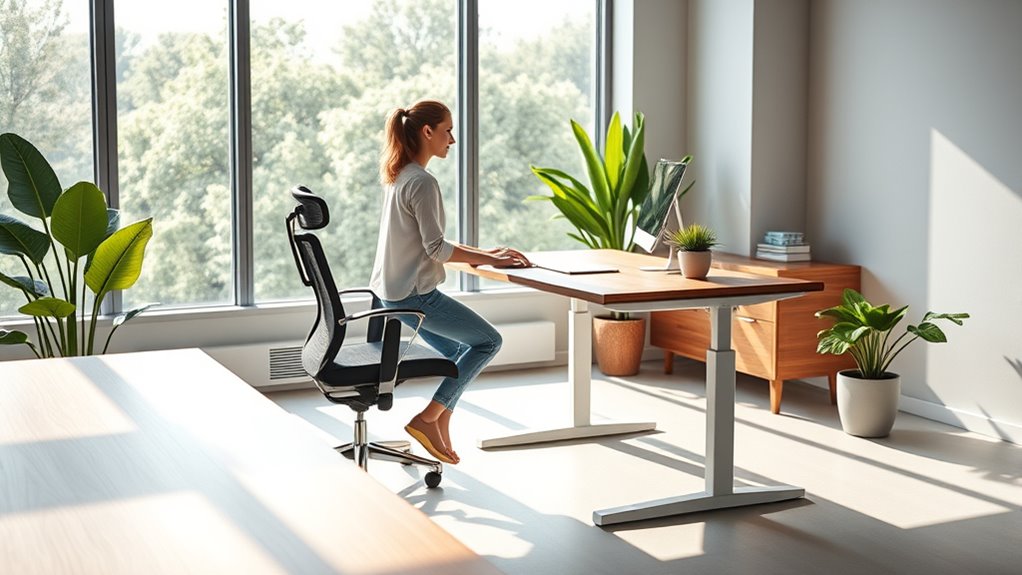Sit-stand desks can seriously improve your posture and spinal health by encouraging a neutral spine and reducing slouching. They boost focus and mental clarity by supporting blood flow and preventing fatigue. Plus, they promote better circulation, helping you avoid sluggishness and discomfort. These desks also make it easy to move and stretch, keeping your body active throughout the day. Keep going to discover even more ways sit-stand desks can transform your workday.
Key Takeaways
- Promote better spinal alignment and reduce chronic back pain through ergonomic support.
- Boost mental clarity and focus by preventing fatigue with varied sitting and standing positions.
- Improve circulation and decrease fatigue by encouraging movement and blood flow throughout the day.
- Enhance flexibility and reduce stiffness with adjustable heights and dynamic movement options.
- Support long-term energy levels and mood by reducing sluggishness and fostering a more comfortable workspace.
Boosts Your Posture and Spinal Health

Using a sit-stand desk can substantially improve your posture and spinal health. By making ergonomic adjustments, you guarantee your workstation supports proper spinal alignment, reducing strain and discomfort. When you switch between sitting and standing, it encourages you to maintain a neutral spine position, preventing slouching and hunching. Proper ergonomic setup helps keep your head aligned with your shoulders and your hips in a healthy position. This not only alleviates pressure on your lower back but also promotes better overall spinal health. Regularly adjusting your desk height ensures you’re not forced into awkward postures, helping you sustain good posture throughout the day. Over time, these small changes can markedly reduce the risk of developing chronic back pain and spinal issues. Additionally, integrating ergonomic technology such as adjustable desks with AI-powered features can further optimize your workspace for comfort and health.
Enhances Focus and Mental Clarity

Switching between sitting and standing at your desk can considerably boost your focus and mental clarity. When you vary your position, you prevent the fatigue and sluggishness that come from prolonged sitting. Using ergonomic accessories like adjustable monitor arms and footrests helps you maintain proper posture, making it easier to stay alert. This movement encourages better blood flow, which fuels your brain and sharpens mental agility. Standing breaks also break up monotonous work sessions, helping you stay engaged and attentive. Incorporating proper ergonomics into your routine can further enhance comfort and reduce strain, making it easier to maintain productivity throughout the day. As a result, you’ll find it easier to concentrate on tasks, solve problems, and think creatively. Incorporating sit-stand routines into your day maximizes mental clarity, giving you the energy to perform at your best without feeling drained or distracted.
Promotes Better Circulation and Reduces Fatigue

Alternating between sitting and standing encourages healthy blood flow throughout your body, which can considerably reduce fatigue. When you switch positions regularly, you prevent blood from pooling in your legs and feet, keeping circulation smooth. Using ergonomic accessories like footrests or anti-fatigue mats can support your posture and make standing more comfortable. Incorporating ergonomic accessories such as footrests or anti-fatigue mats can support your posture and make standing more comfortable. Incorporate simple circulation exercises, such as calf raises or ankle rotations, to further boost blood flow. These quick movements help prevent stiffness and keep your energy levels up. By making these small adjustments, you reduce feelings of sluggishness and promote better overall circulation. This proactive approach helps you stay alert longer and minimizes the fatigue that often accompanies prolonged sitting.
Facilitates More Dynamic and Flexible Movement

Sit-stand desks naturally encourage you to move more throughout the day, fostering greater flexibility in your routine. With ergonomic adjustments, you can easily switch between sitting and standing positions, promoting more dynamic movement. The adjustable height feature makes it simple to customize your workspace, allowing you to shift positions as needed. This flexibility helps break up long periods of inactivity, giving you the opportunity to stretch, stretch, and change your posture frequently. Moving more freely reduces stiffness and encourages muscle engagement, making your workday more active. By incorporating these ergonomic adjustments, you create a workspace that adapts to your body’s needs, empowering you to stay mobile and engaged throughout the day.
Encourages Long-Term Energy and Mood Improvements

By incorporating sit-stand desks into your daily routine, you can experience sustained boosts in energy levels and mood over time. These desks promote better circulation and reduce fatigue, helping you stay alert longer. Using ergonomic accessories like supportive mats or keyboard trays complements adjustable desk heights, making changeover seamless. To maximize mood benefits:
- Switch between sitting and standing regularly to prevent sluggishness.
- Customize your desk height to find the most comfortable position.
- Incorporate movement breaks to boost mental clarity.
- Maintain good posture to avoid discomfort and sustain positive energy.
- Implementing ergonomic setup strategies can further enhance comfort and productivity.
Over time, these habits help stabilize your mood and increase energy, making your workday more enjoyable and productive. The key lies in consistent use and ergonomic setup to support your well-being.
Frequently Asked Questions
Are Sit-Stand Desks Suitable for Small or Limited Workspace Areas?
If you’re wondering whether sit-stand desks suit small or limited spaces, the answer is yes. Their compact design guarantees they fit comfortably without cluttering your workspace. Plus, they promote space optimization by providing versatile, adjustable surfaces that can be easily stored or moved when needed. This makes sit-stand desks a smart choice for optimizing limited areas while enhancing your comfort and productivity.
How Do Sit-Stand Desks Impact Overall Ergonomic Setup and Accessories?
You can substantially improve your ergonomic setup with a sit-stand desk by carefully choosing desk accessories that support ergonomic principles. Adjustable monitor arms, keyboard trays, and footrests help reduce strain and promote proper posture. By integrating these accessories, you guarantee your workspace remains comfortable and adaptable, encouraging movement and preventing discomfort throughout the day. This smart setup boosts productivity and keeps your body aligned, making your workspace both functional and ergonomic.
Can Sit-Stand Desks Help Alleviate Specific Pre-Existing Back or Neck Issues?
Sit-stand desks can considerably help alleviate back and neck issues by promoting ergonomic posture. When you alternate between sitting and standing, you reduce strain on your spine and neck muscles, which may provide chronic pain relief. Using these desks encourages proper alignment, prevents slouching, and minimizes discomfort caused by prolonged static positions. As a result, you can experience healthier movement patterns and better overall comfort during your workday.
What Are the Maintenance and Durability Considerations for Long-Term Use?
When considering desk maintenance and durability factors for long-term use, you should regularly clean and inspect your sit-stand desk to prevent mechanical issues. Choose a model with sturdy materials and reliable components to guarantee durability. Properly lubricate moving parts and tighten screws as needed. Avoid overloading the desk beyond its weight capacity, and follow the manufacturer’s maintenance instructions to extend its lifespan and maintain smooth, safe operation.
Are There Any Safety Concerns or Risks Associated With Transitioning Positions Frequently?
When shifting positions frequently, you should be aware of potential safety concerns like strain or imbalance. To minimize risks, use ergonomic accessories and guarantee your workspace layout supports smooth movement. Adjust your desk properly to avoid awkward postures, and take regular breaks. Being mindful of your posture and workspace setup helps you stay safe and comfortable, preventing injuries and making your sit-stand desk experience more effective.
Conclusion
So, there you have it—sit-stand desks are basically your new best friends, secretly transforming you into a posture-perfect, energy-boosted superhero. Who knew swapping between sitting and standing could do so much? Just think, soon you’ll be impressing everyone with your newfound focus, circulation, and mood. All this magic, and all it takes is a simple desk. So go ahead, embrace the change—your back, brain, and future self will thank you.









